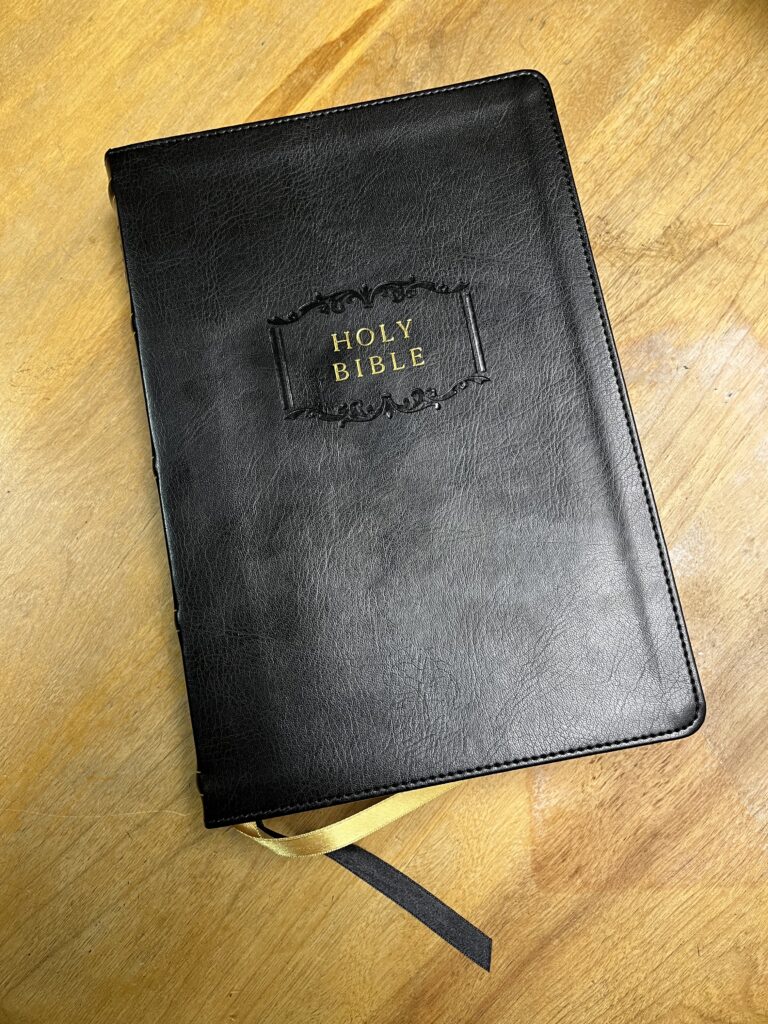
I recently did something that I haven’t done before: I purchased my own KJV Bible. Now while I have been gifted a copy or two over the years and have certainly had parallel Bibles that included the KJV, this was really the first time that I had actually purchased a copy for myself. I was spurred on to acquire this edition through the combination of a comment in a previous post and a well-timed advertisement from Thomas Nelson. It seemed that it was meant to be or perhaps just a coincidence or maybe my phone was analyzing and sharing my data! 🙂 Either way, I decided to go with the Black Leathersoft edition simply because I didn’t want to spend a whole lot of money on a Bible I may not use that often. I ended up spending under $50 with free shipping from christianbook.com. The Leathersoft is pretty much what you would expect from that material, but the perimeter stitching is a really nice touch.
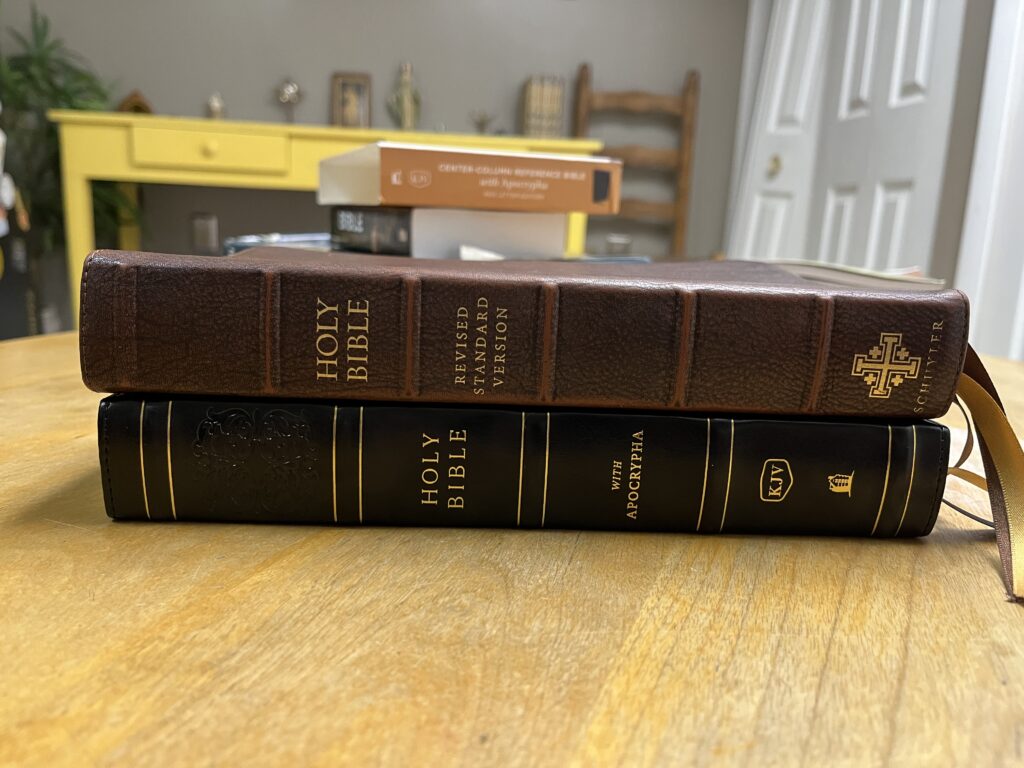
Here are the listed features for this Bible:
- Presentation page to personalize this special gift by recording a memory or a note
- 15 Books of the Apocrypha placed between the Old and New Testaments for spiritual insight and historical context for certain books of the Bible
- Old Testament and New Testament books include over 73,000 center column cross-references and translator notes allow you to find related passages quickly and easily
- Book introductions for Old Testament, Apocrypha, and New Testament provide a concise overview of the background and historical context of the book about to be read
- “About the Apocrypha” article describes what the apocrypha is and its importance
- “About the Bible” article
- “How to Study the Bible” article for tips on how to find deeper truths in Scripture
- “Getting to Know God” article is a guide to a personal relationship with God
- “Between the Testaments” article for historical context leading up to the New Testament
- The History of the Red-Letter Bible” article
- “30 Days Getting to Know God” reading plan for key passages for a better understanding of key characteristic of God
- “30 Days Getting to Know Jesus” reading plan for a highlight of key moments in Jesus’ earthly ministry
- Full-color maps show a visual representation of Israel and other biblical locations for better context
- Two satin ribbon markers for you to easily navigate and keep track of where you were reading
- Durable Smyth-sewn binding lies flat in your hand or on your desk
- Clear and readable 9.5-point KJV Comfort Print
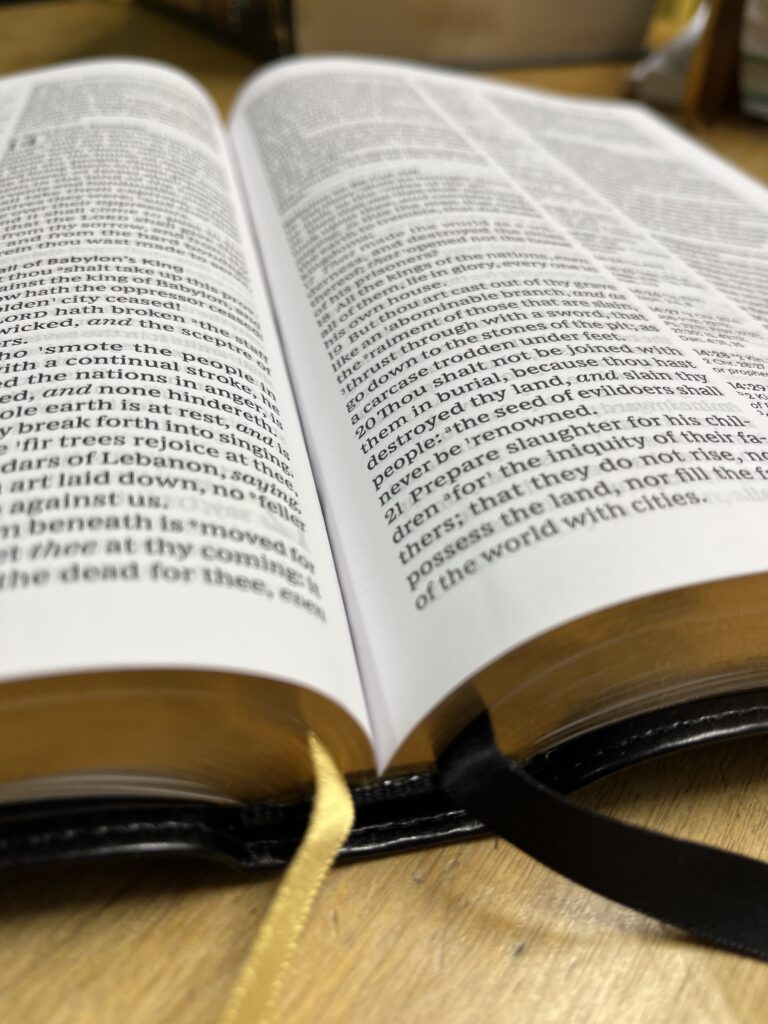
Let me just give a few first impressions after spending about a week with this Bible: 1) Even though I am not a huge fan of the “Easy to Read Comfort Print” font, I find this Bible super easy to read from. This is due primarily to the dark print and line-matching, but also the spacing on each page, which includes a generous one inch margin. The 9.5 font and the 30 gsm paper are perfect for a Bible like this. 2) The Apocrypha books do not contain center-column references. You will notice that the columns are larger than the rest of the bible because of that. They include the standard Catholic Deuterocanonicals as well as 1-2 Esdras, Prayer of Manasses, and 3 Maccabees. 3) The red-lettering is done well. I am not a huge fan of red-letter Bibles, but this isn’t a huge distraction at all. 4) The center-column references contain 73,000 references as well as modern renderings of certain English words that may need to be made clearer for the modern reader or perhaps have changed their meaning since this version of the KJV was done. 5) This Bible opens up flat immediately after taking it out of the box. You may need to “work-in” the first and last Biblical books which are closer to the cover, but this is to be expected. 6) It contains seven glossy Zondervan maps. 7) The article on the “History of the Red Letter Bible” was a pretty interesting read, since it wasn’t something I had any prior knowledge of. 8) The intros to each book (including the Apocrypha books) are traditional, focused, concise, and helpful.
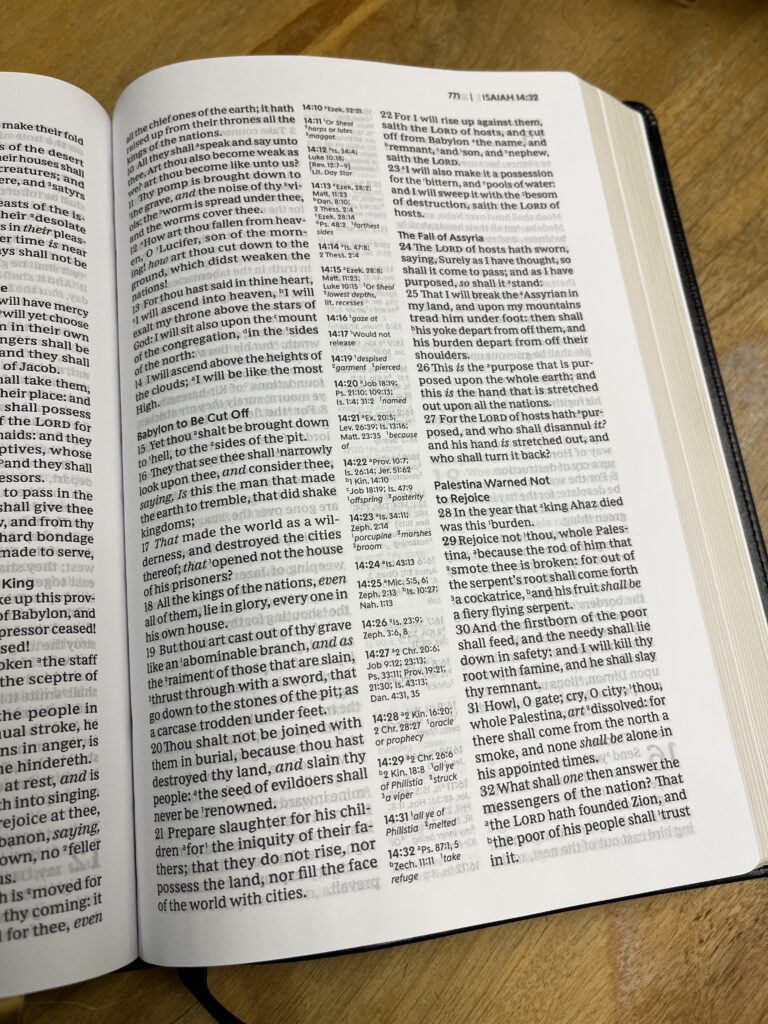
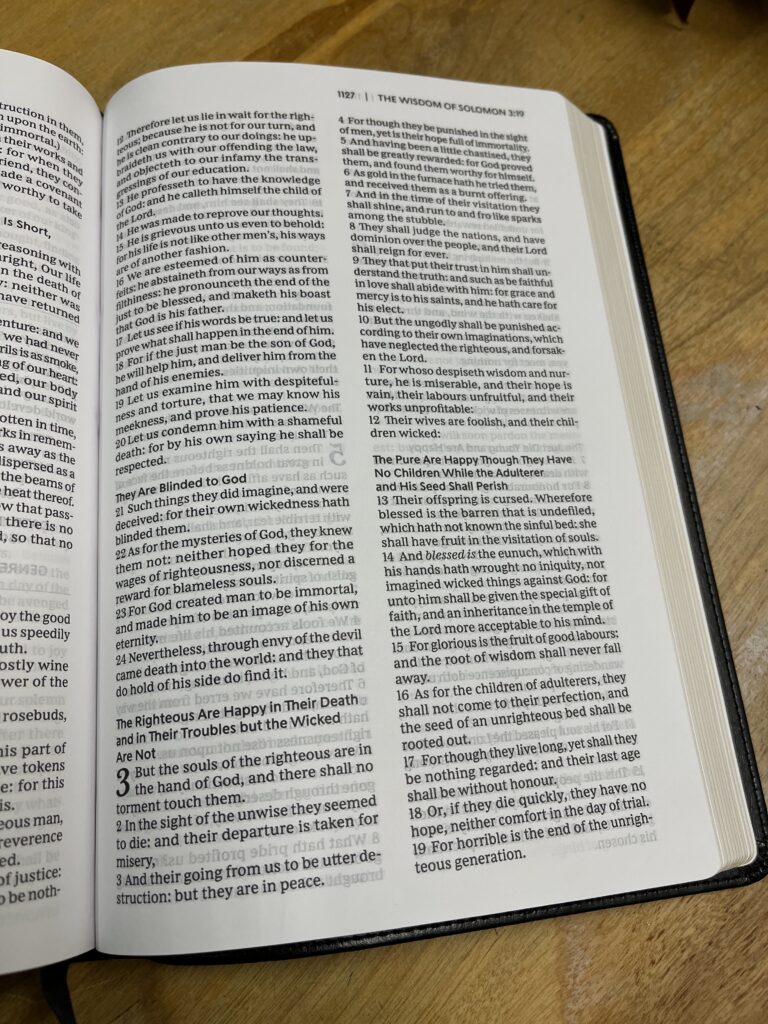
A thought always comes to me when I am looking at newer Bible editions based on older translations: It is remarkable that older translations like the KJV remain popular and available in more modern formats and editions. There are editions like this one, youth editions, study editions, and others which have taken the older language of the KJV and have packaged it in a modern Bible edition. When I think about the Douay-Rheims (or even to a lesser extent the Knox) the options are simply not there. For all the good work that publishers like Baronius or Loreto have done to keep the Douay-Rheims in print, these editions have the look and feel (even if newly re-typeset) of a Bible from around 1908. And I understand that an edition like that will certainly appeal to a certain crowd, but it is my belief that for the popularity of the Douay-Rheims to grow it needs to be offered in the style and format of a modern Bible. Could you imagine a Douay-Rheims Quentel from Schuyler? (BTW, that would never happen.) Or perhaps something like this lovely Thomas Nelson Center-Column KJV w/Apocrypha?
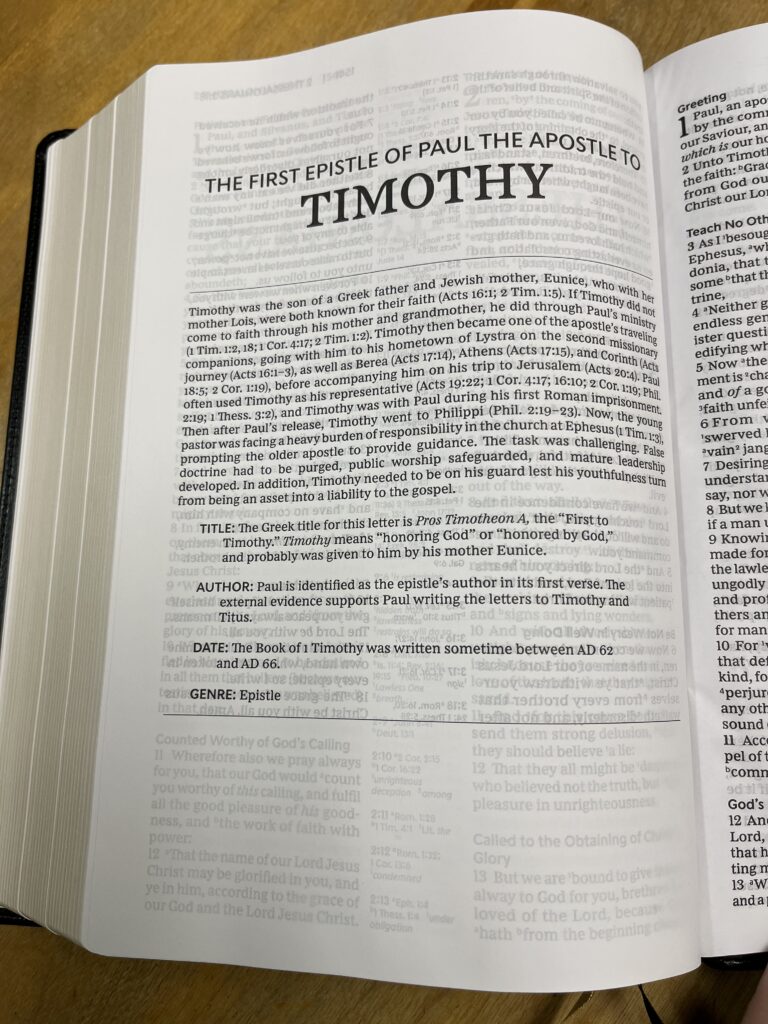
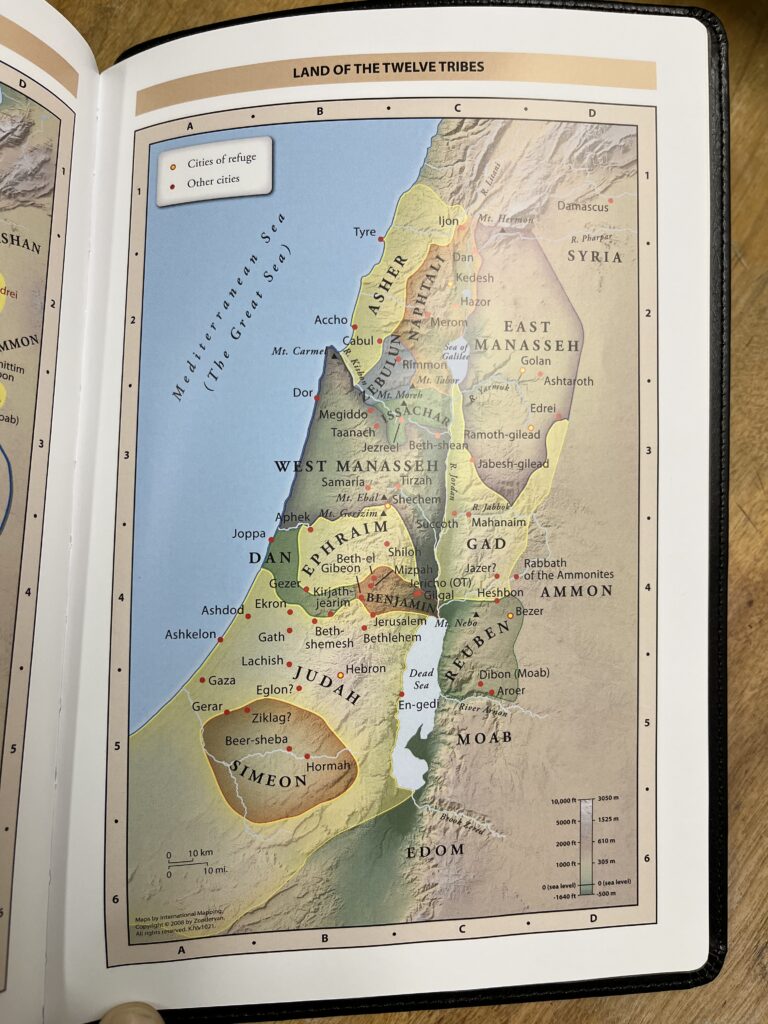
Overall, I am really happy to have purchased this KJV Bible. You can check out the various editions of this bible by heading over to the Thomas Nelson website.
This looks very enticing. I want to stack some discounts and get this alongside a nicer NABRE. One that fits my needs is the HarperOne edition. I know neither edition of the HarperOne NABRE includes a ribbon marker, but besides that would anyone here recommend the leathersoft over the hardcover? I can’t decide if I want both in fake leather or both in hardcover, or one in each.
Michael,
If you are talking about this NABRE, I would recommend the hardcover:
https://www.christianbook.com/new-american-bible-revised-edition/9780062084736/pd/084736?event=ESRCG
The leathersoft version of the NABRE is not very good at all. The one on this KJV is a bit better.
Thanks Timothy! (Also, have you considered doing a collaboration with the coalition of Youtube Bible Reviewer Tims? There’s a lot of you!)
Ha! I probably should, right? I mean I have the name.
Why not wait for the new NABRE ( or whatever acronym is assigned) which is said to be but a few years away from publication?
Timothy,
Thanks for another great review. I like the layout very much (thanks for the pictures, as always).
I would go for it, but a couple of years ago I purchased the New Cambridge Paragraph Bible, edited by David Norton (w/ Apocrypha/Deuterocanonicals), with a black calfskin cover. I was inspired to purchase a KJV by Dr. Peter Kreeft, who speaks very highly of the KJV (albeit acknowledging its defects) and apparently uses it for his personal prayer. I found a discounted “imperfect” copy from Christianbook.com (if there are any flaws, I couldn’t find them). It’s a beautiful edition, though I like the interior format of the Nelson better and appreciate that it has introductions to the books, whereas the Cambridge doesn’t (though it does have some helpful translation notes in the margins).
I love the language of the KJV (even if it translates a Hebrew word for wild ox or horned beast as “unicorn”!). Yuo were wise to get the leather soft edition because my KJV, as much as I enjoy it, is not my primary bible— I primarily use the Schulyler RSV and Cambridge Diadem ESV (both w/ Deuterocanonicals), along with the NRSVCE these days).
Even as a Catholic, I prefer the KJV over the Douay-Rheims. I find the historical connection between the KJV and the DR fascinating. I agree that it would be great to have a DR or Knox printed in a modern format rather than what you’d find in your grandfather’s library, with the dense printing, crowded margins, etc.
Leighton,
We are on the same page for sure. And I feel like I may have had that Cambridge edition at one point, though I am quite happy with this edition. And yes, I do seem to remember Kreeft saying something about the KJV much like you recalled.
I grew up (Protestant) in a KJV only church. I never read another translation until I was in my 30s and became Catholic. I initially used a NABRE because, well, that’s the mass translation, and it’s fine. But eventually I branched out and tried the DR. That was a non-starter for me. After spending so much time with the KJV, the DR is so awkward and stilted! Just my opinion of course, but I didn’t find it beautiful or uplifting. This edition with apocrypha is really interesting. I think though, that when I want that beautiful KJV language, I’ll just use my grandma’s Bible…not a complete Catholic Bible, admittedly, but honestly, how much time do I spend in the apocryphal books anyway? If I want to read them, I can use my ESV Diadem with apocrypha from Cambridge (that you reviewed! It’s beautiful!).
Angela,
Thanks for sharing a bit of your story. Yeah, use your grandma’s Bible! With that special connection to her, you should absolutely use it. That is truly a gift!
And yes, the Diadem is lovely. There are some really nice editions available right now in some really good translations.
I am pretty sure that it doesn’t have 3 Maccabees since the KJV Apocrypha don’t have it (because it was never in the appendix to the Latin Vulgate).
Ales,
I can assure you it is included. I am looking at it as I write this.
Odd… does it say anything about where they got the text for 3 Maccabees?
I did a quick look through it and it doesn’t seem to indicate where they got the text from.
Do have any versions without 3 Maccabees. I don’t want no 3rd Maccabees.
The current theory is that they lifted the 3 Maccabees text from the Orthodox Study Bible.
It’s the same publisher, so that would kind of explain it, but wouldn’t the writing style be very different? Amazon’s preview shows the first verse and a half from 3 Maccabees in the Orthodox Study Bible. Timothy, is this how 3 Maccabees starts in your KJV?
“When Philopator heard from those who returned that the regions he ruled had been captured by Antiochus, he issued orders to all his infantry and cavalry forces, took his sister Arsinoe along with him, and set out toward the area near Raphia, where the forces of Antiochus were positioned. Now a certain Theodotus, intending to carry out a plan he had developed, took the finest of the Ptolemaic weapons issued earlier to him and crossed by night to Ptolemy’s…”
Philip,
It is not. Here is the first verse:
“But when Philopator learned from those who had returned that Antiochus had taken from him the regions he had possessed…”
Interestingly enough, a search of this verse reveals no exact matches… That’s weird
Well, that’s a weird mix. But then, it seems they’ve forgotten about Psalm 151.
As well as 4 Maccabees, but that one is absent from the OSB.
I am not a fan of the KJV, yes many of its phrases have become iconic, so many that many English proverbs actually come from the KJV. The English language owes it a huge debt. But it is a badly flawed translation, although many of its passages are well known, but scholars have known for more than 150 years that a lot of those passages are poor translations of the original language.
One excellent example is in the Gospel of Matthew, where the Magi tell Herod “when have seen his star in the east”, this is now known to be a mistranslation, which is why translation since about 1982 word this verse “we have seen his star at its rising”, a translation which, you must admit, makes a lot more sense in context. Several hundred other examples could be given. The cutting edge of 17th-century scholarship is not so cutting edge 400 years later.
And much of it sounds like it makes sense until you do the research and realize that the words and realize that in 400 years a lot of the words in the KJV now mean the exact opposite of what they meant in 1611, so those passages don’t mean what you think they do.
And there are numerous obvious typos in the text that have oddly never been corrected, one example of this being Jesus condemning the Pharisees for “straining at a gnat and swallowing camels”, this makes no sense, it is obviously supposed to say “straining OUT a gnat” why has this never been corrected?
But the biggest problem with the KJV is that it is an anti-Catholic translation. The preface, which makes an extended attack on “Romanism” makes the intention behind the translation clear. And if you compare the KJV to a modern ecumenical translation, the bias becomes apparent.
What is significant about this edition is what is included is not the “translators notes” as the listing states, but they are actually explanatory notes for the archaic English.
These are sometimes included in KJV Bibles, most commonly Thomas Nelson Editions, but finally having them in an edition with the Deuterocanonical books is worth mentioning.
I know that the KJV is pre-modern English, not old English, but there are many words and phrases in the KJV that are either unfamiliar or no longer have the same meaning today, so the language notes are very important.
This may be wishful thinking but I hope this release signifies a step towards ecumenism.
Jonny,
The inclusion of the “translators notes” sort of goes along with my comment about publishing the KJV in a modern edition. Imagine if someone could do the same with Douay-Rheims, including similar “translators notes” for words that would be difficult for modern readers in a modern bible edition. Perhaps that might be asking too much? Perhaps there isn’t a need?
Tim,
The Challoner would greatly benefit from a “modernized” edition. At the very least modern punctuation and formatting. The verse format and bizarre punctuation butchers the text a great deal, especially in the Psalter. Beyond this, notes on the translation itself would be helpful, much like this new KJV. To say the the language of the DRC is cumbersome is an understatement, I would argue the notes should be there.
I don’t think anyone could fault the above suggestions, but more drastic changes could be made as well. Updating the proper names to modern usage would make the Bible more useful. Also, syntax and grammar could be improved without changing the translation itself, just to make the English more comprehensible.
Things have come full circle. Timothy has gone from reading The Message to the KJV.
Head to confession straight away. The Parousia is nigh y’all.
😉
Steve,
I have eclectic tastes, what can I say?
Let me just say that I am not reading the KJV regularly at all. I like the edition, but it’s a niche translation for me. The MSG served a purpose for me at a particular time and am glad it was there when I needed a break. I still enjoy referring to from time to time. And I deeply appreciate Eugene Peterson, much in the same way I do Msgr. Knox.
Jonny, there is an updated New Testament for the Challoner, though it does not go nearly as far as you would wish. It is the Confraternity version. It came out in the 40s and is in print from Scepter, and also through Sophia Institute Press in a peculiar readers edition. It is definitely the most readable translation of the Vulgate into English, though I greatly prefer the Knox.
Just spotted this on Reddit and I thought it would be relevant to the bible lovers here. Apparently a recently released Tenebrae supplement for the Ordinariate of Our Lady of Walshingham’s Divine Office has all 9 of it’s Lessons (Scripture Readings)taken directly from the KJV.
The original poster called this a victory for the KJV and speculated it may be a sign that there is interest within the Anglo-Catholic Ordinariates to seek full liturgical approval for the KJV in the future. I attend an Ordinate Mass myself and I do know that certain phrases in the Mass, as well as the entire reading of the “Last Gospel” (John 1:1-14) at the end of Mass are taken entirely from the KJV, so I wonder if the poster may be on to something.
I’m including links to the original Reddit post and an online copy of the Tenebrae supplement itself below:
Post: https://www.reddit.com/r/AnglicanOrdinariate/comments/13o6jl3/a_recent_victory_for_the_kjv/
Tenebrae Service: https://www.ordinariate.org.uk/cmsAdmin/uploads/dwdo(ce)-holy-week-&-easter-supplement-approved.pdf
I’d be in favor of a Catholic KJV lectonary for use within the Ordinariate’s at least, that just seems like it makes sense to me. Plus, I’d love to be able to purchase a KJV:CE that isn’t from an on demand printer someday.